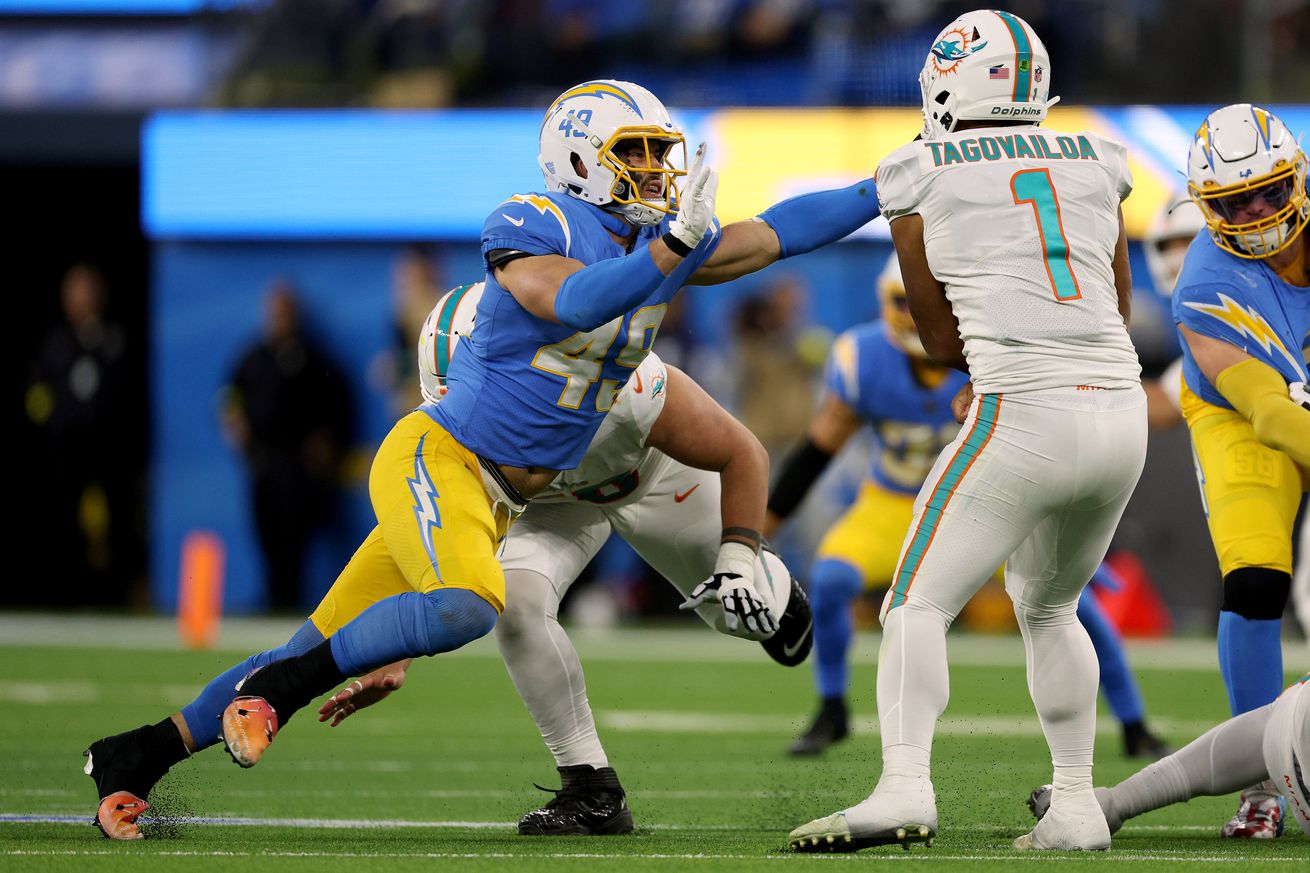
Photo by Harry How/Getty Images
In the Herbert-Tagovailoa battle, Brandon Staley came out as the winner
The war for the soul of football Twitter was fought on Sunday night between the Los Angeles Chargers and Miami Dolphins. SoFi Stadium was the battlefield and the main stars were Justin Herbert and Tua Tagovailoa, QBs from the same class who have caused divisions among friends and created many heated family discussions.
However, as the dust settled on the game, it was Brandon Staley and the Chargers defense that stole the show. The Chargers won 23-17, but the game never felt that close. Tagovailoa threw for only 145 yards on an abysmal 10-28 clip, and the Dolphins signal caller posted an EPA/play of -0.085, putting him below Tyler Huntley and Sam Darnold. The explosive Dolphins offense was stymied once again, and how Staley and the Chargers did it was extremely interesting.
The Chargers played an extremely large amount of man coverage on the Dolphins. The Dolphins normally don’t see a lot of man coverage—before the Chargers game they were 29th in the NFL in dropbacks against man coverage, but the Chargers played man on a majority of the coverages. Not only did they play man, but they would press receivers Tyreek Hill and Jaylen Waddle. This always comes at a risk with their speed, but what they did was disrupt the timing of all the Dolphins concepts.
Let’s start with the Dolphins favorite passing concept, this slide flat RPO. RPO’s normally work really well against zone coverage because they pick on a player in conflict, normally an overhang slot defender or linebacker. In man coverage, there’s no man to put in conflict, because they’re guarding a man. RPOs are built on timing, and with the Chargers pressing and playing man, there’s both no conflict man or proper timing—advantage Chargers.
When the Dolphins would try to stretch the field, the press coverage would again negate timing, but what the Chargers did was play a lot of Cover One Robber. This drops a safety right into the middle of the field, where the Dolphins love attacking. Essentially this is creating a double team on whatever in-breaking route comes across and forces Tua away from the throw.
On this Kyle Van Noy sack, LB Drue Tranquill goes from the line of scrimmage to the deep middle of the field, and the two safeties play Robber on the middle of the field and Tyreek Hill. The Chargers changed the picture massively while taking away the middle of the field, resulting in a sack (sweet spin move by KVN too).
This is another example here of the Chargers playing tight man coverage and forcing the issue to Miami. The Dolphins bring Jaylen Waddle in motion, and watch how effectively the Chargers pass off these routes and shut off the airspace for any routes to develop. Add in the robber coverage and you get another perfect defensive rep.
Up front, the Chargers won for a large majority of the game. On passing downs, the Chargers would use the threat of Khalil Mack and exploit the Dolphins weak points on their OL.
On this Morgan Fox sack, the Chargers are in a loose 4 man front, with edge rushers Khalil Mack and Kyle Van Noy lined up over the right side of the OL. Because that’s Khalil freakin’ Mack the Dolphins slide their protection to the right. The Chargers know they’re going to slide it, and have Kenneth Murray walk up on the left side and feign a blitz, forcing the center to make a choice. The center slides to Mack’s side as Murray drops, leaving Fox with the left guard one on one. Fox wins that matchup and gets a sack.
Drue Tranquill also made some awesome plays as a blitzer, including forcing this intentional grounding. The Dolphins slide their protection to the right, expecting the left side of the line to sort out anything weird that happens. Well, Tranquill adds on as a blitzer, but Van Noy drops from the other side, meaning the numbers stack up well for Miami. However, the nose guard holds up the Dolphins LG enough to let Tranquill get through to cause disruption, then he ends up free.
The Niners game for Miami could be washed away as a bad game, but this Chargers game just feels odd watching it over again. If teams are more than willing to press and play man (which I thought should’ve been the idea all along), then it forces Tagovailoa to create out of rhythm and off schedule. The RPOs don’t work as effectively, and if the Dolphins aren’t able to (or choose not to) run the ball effectively to replace their quick game (0.1 EPA/attempt on 16 attempts), they could struggle.
Los Angeles potentially found the formula to slowing down Miami’s offense, and it could be something teams copy as Miami goes forward. Saturday’s game in Buffalo now looms large not only for the division, but in the grand scheme of the NFL playoff picture.

Must See
-


American Football
/ 2 hours agoMaybe the Thunder could have stopped the Mavericks by not helping them at the NBA trade deadline
Photo by Joe Murphy/NBAE via Getty Images The Thunder saw their season end in...
By -


American Football
/ 2 hours agoMax Verstappen or the field at the F1 Emilia Romagna Grand Prix?
Photo by Mark Thompson/Getty Images Once again the F1 world wonders: Can anyone catch...
By -


American Football
/ 3 hours agoPGA Championship Round 3 Winners, Losers: Shane Lowry thrives, Scheffler struggles
Photo by Michael Reaves/Getty Images The third round of the PGA Championship had numerous...
By





